Amazon is the world’s largest and leading eCommerce platform with millions sellers and active users across the world. For any serious Amazon seller, advertising is the way to stand out on the platform. Investing in PPC campaigns not only generates traffic in the short run but also improves a product’s organic ranking in the long run.
However, it’s not enough to simply spend on advertising. A wise seller would aim to maximize ad spending. To do that, they must understand these critical ad metrics and how to use them to improve their PPC campaigns.
Amazon Advertising Statistics (2023):
Importance of Amazon PPC Ads
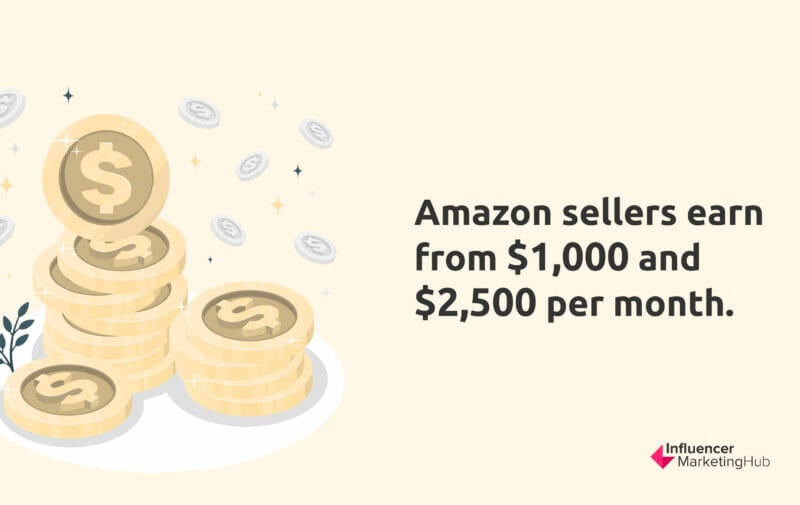
According to Helium 10, nearly 50% of Amazon sellers earn anything between $1,000 and $2,500 per month. That said, some Amazon sellers have indicated that they make as much as $45,000 per year.
- Better product visibility
- Higher sales and revenues
- Improved brand trust and credibility
- Highly targeted audience reach
- Access to new and more diverse clients
As a seller, you can have the perfect winning products, but if they are not visible to the right market, you still lose out on potential sales. Using Amazon PPC Ads (pay-per-click ads), you place your product listings right in front of customers. The moment they search using your product’s keyword, your listing will be at the top of search results.
Amazon PPC Ads also help you to reach buyers, instead of viewers. You can be sure that people who click on your ads have high intent to buy. What’s best is that you are only charged for every click, not the number of people who see your ads (impressions).
Now that you know how important Amazon PPC Ads are, and have decided to create and run them, your next question should be, how do I know which ads are working?
Important Amazon Ads Metrics
Increased sales and revenues are the best gauges to know if your ads are really working. But they are not the only ones. There are a lot of data points that will tell you if your ads are resonating with your customers or not.
Here are other critical metrics you need to know:
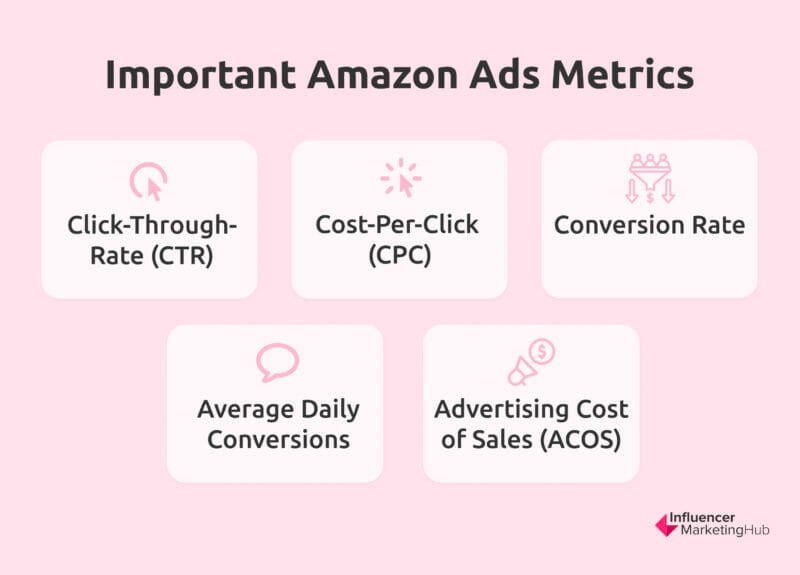
- Click-through rate (CTR)
- Cost per click (CPC)
- Conversion rate (CVR)
- Average daily conversions
- Advertising Cost of Sale (ACOS)
Understanding these metrics will help you evaluate your campaign’s performance and ensure those advertising dollars are well-spent.
Click-through-Rate (CTR)
Click-through rate is the most integral component of any PPC campaign. It tells you the ratio of the number of clicks versus the number of impressions your ads receive. It is crucial in letting you know whether your ads work in attracting customers to click on them.
According to an article shared on LinkedIn, the average click-through rate for the three main types of Amazon Ads are as follows:
- For Sponsored Products, it’s about 0.42%.
- For Sponsored Brands, it’s about 0.38%.
- For Display Ads, it reaches approximately 1%.
Your CTR must be equivalent or above that. If it’s lower, you should consider tweaking some parts of your ads to make them more compelling or optimizing your keyword targeting to find the right customers.
Ways to Improve CTR
To improve your CTR, you should do the following:
- Review if the following parts of your ads are compelling:
- Ad Headline - Is it descriptive, accurate, creative, and unique?
- Image - Is it a high-quality, realistic image?
- Reviews - Is the product highly reviewed with a good review score?
- Price - Is the price competitive?
- Check if your ads are using the right keywords which could be:
- Broad keywords
- Exact keywords
- Phrase keywords
- Negative keywords
Cost-per-Click (CPC)
Cost per click (CPC) refers to the actual ad cost you pay for every click the ad receives. This is calculated as the total ad spend divided by the number of clicks. Advertisers bid for clicks and your goal is to outbid your competition to get the best position and visibility to reach your customers.
The average CPC for Amazon Ads for 2023 is $0.91 in the United States, according to Ad Badger. The US has the highest average CPC and in other countries, like Italy, it’s more than half lower.
However, lower CPC means higher ROI, so your goal is to optimize your campaigns to achieve the lowest CPCs. You can do this by running ads that accurately target your customers but do not attract high competition.
Ways to Lower CPC
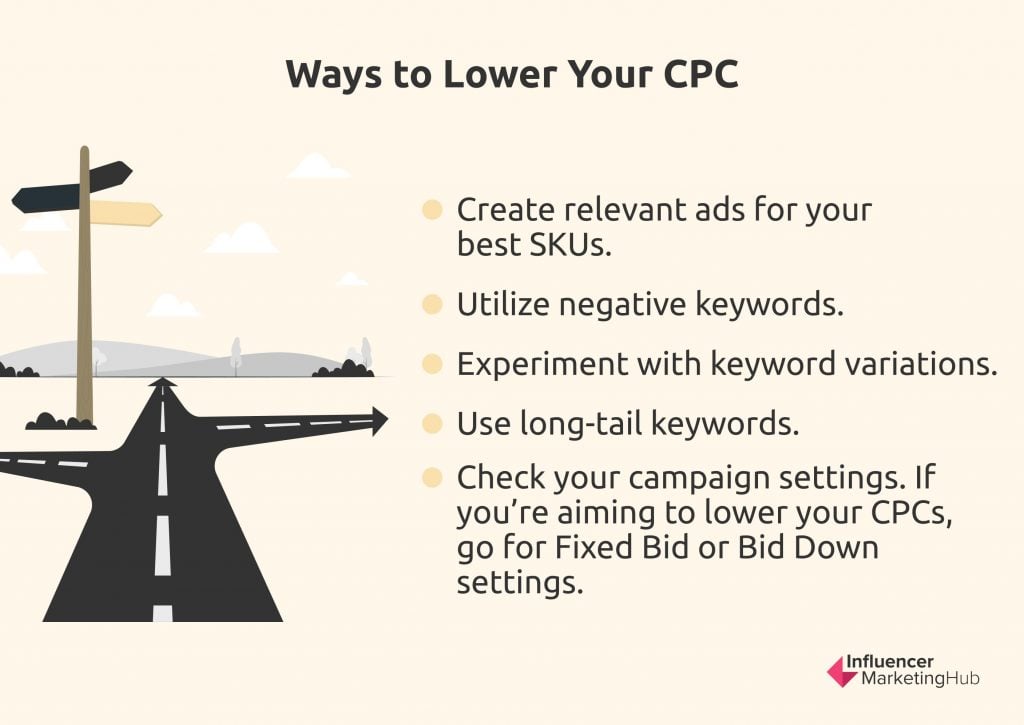
Here are quick ways to lower your CPC:
- Create relevant ads for your best SKUs.
- Utilize negative keywords.
- Experiment with keyword variations.
- Use long-tail keywords.
- Always check your campaign settings. If you’re aiming to lower your CPCs, go for Fixed Bid or Bid Down settings.
Conversion Rate (CVR) and Average Daily Conversions
A conversion happens when the customer clicks on the ad then makes a purchase. Conversion rate measures this event. It’s calculated as the ratio of the number of conversions (purchases) versus the number of ad clicks.
Conversion does not measure units sold since one conversion can be equivalent to multiple units sold. This means the potential for higher sales for every conversion is huge.
Amazon’s average conversion rate is estimated at between 10% and 15%. This is higher than the average for other eCommerce platforms which is at 1% to 2% depending on the industry.
This proves that visitors to Amazon’s websites are serious buyers. They are at the bottom of the sales funnel and are ready to buy. You just need to convince them that your product is what they’re looking for.
Keep in mind that the conversion rate per niche varies. Some products like luxury items are known to have lower conversion rates since buyers would typically shop around before making a purchase. Most Amazon sellers start as an FBA seller, but if your products become part of the Amazon Prime network, conversion rates can be as high as 74%, according to data shared by eComCrew. The reason for this is that many people who visit Amazon have made up their minds about buying something.
Factors Affecting Conversion Rate
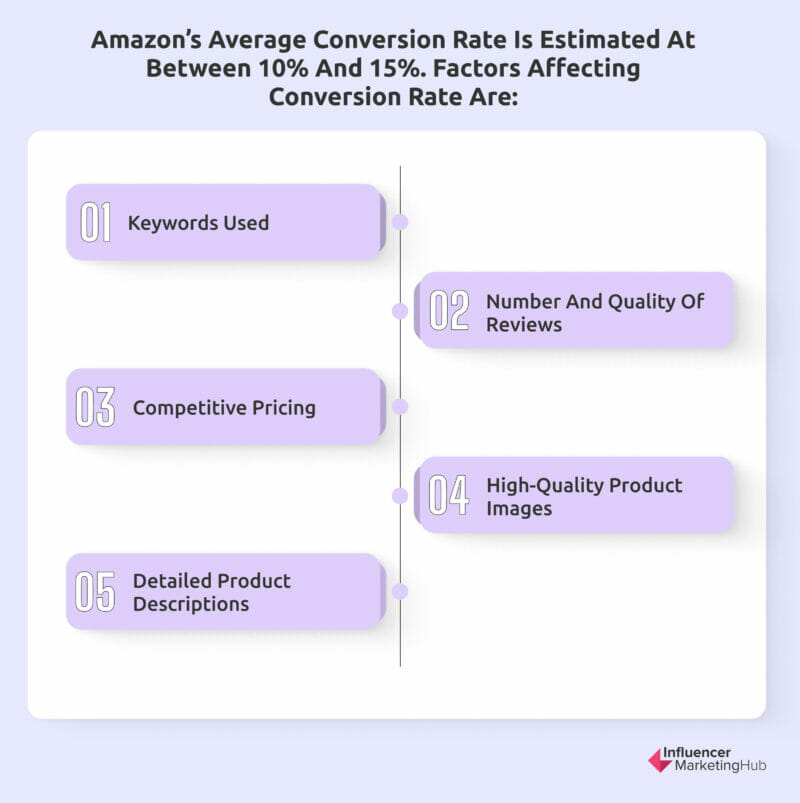
To optimize conversion rates, you need to understand the following factors affecting them:
Keywords used
Always conduct comprehensive keyword research and make sure you're using the right keywords for your products. While "Christmas Tree" may be a good keyword, if you're selling "Christmas garlands" and use this keyword just to increase impressions and clicks, people will quickly leave your listing because they won't find what they're looking for.
Number and quality of reviews
Customers love social proof and having a lot of high-quality reviews on your listing will affirm their choices. Your products’ reviews should be relevant and not sound forced.
Competitive pricing
Remember that there are thousands of sellers selling the same item on Amazon, and customers would always compare prices. Having a competitive price will ensure that customers consider your products.
High-quality product images
Product images are the primary way customers are attracted to your listing. Use professionally shot product photos that will stand out in a sea of similar search results. In highly competitive listings, product titles and descriptions may be similar, and the only way to stand out is with an eye-catching photo. Just make sure the photo is still representative of the actual item being sold.
Detailed product descriptions
Lastly, don’t forget the product descriptions. You need to create accurate and keyword rich product descriptions. These are important for customers to understand what your product is all about and what value-added services you can offer to stand out from the competition. Also, having an optimized product description will help in your organic rankings.
Ways to increase conversion rate
If your conversion rate is lower than Amazon’s average, there are quick ways to increase it. Here are some of them:
- Use Amazon keyword tools to find the appropriate keywords for your product titles and descriptions.
- Highlight your product’s benefits in the product descriptions.
- Include photos that show how your product is used.
- Use Amazon Seller software to monitor your competitor’s prices and ensure you’re not too high or too low.
- Aim for your products to become Amazon Prime eligible.
- Encourage your customers to leave product reviews.
However, conversion is not the only important metric. It’s dangerous to be fixated on conversion without understanding the other metrics, especially those that relate to profitability.
Advertising Cost of Sales (ACOS)
Advertising Cost of Sales (ACOS) tells you how much ad spend you incur for every $1 revenue earned. This is a great metric to gauge how profitable your campaigns are. To calculate this, simply divide your total ad spend by the number of generated sales.
According to the Sellics Benchmarker Annual Report 2022, the ACOS has increased by 7.5% for Sponsored Products. It shows that the ad environment on Amazon has become increasingly competitive. Their data suggest that the median ACOS has increased from just over 33% to 35.6% of ad revenue. In other words, this means an ad spend of $0.35 for every $1.00 sale.
How to set the right ACOS target
Ideally, you’d want the lowest ad spend for the maximum revenues. This means finding the right target for your ACOS. To do this, you need to:
- Determine your target profit.
- Understand your break-even point.
What you spend for advertising should be less than your ideal profit margin. Your profit margin is the amount left after you’ve paid for all the general costs like shipping, salaries, and fees. You’d be better informed in deciding the right amount of ad spending when you know the other costs your business incurs.
Sometimes, especially when you’re introducing a product, you may have to spend more on advertising. You need to determine the break-even ACOS. This is the maximum amount you can spend on advertising without sacrificing product costs. You don’t suffer a net loss but also don’t enjoy a net gain.
Return on Ad Spend (ROAS)
In Q1 2023, advertisers sought maximum return on ad spend (ROAS), a critical efficiency indicator in the current economy. Sponsored Display ads saw the fastest ROAS growth, but Sponsored Products maintained the highest ROAS.
Amazon's Q1 2023 data shows a 5% year-over-year ROAS increase for Sponsored Products, the dominant ad format, despite market challenges. Sponsored Display ads also experienced a promising 9% ROAS growth, indicating effective advertiser utilization.
While ROAS is crucial, focusing solely on ad efficiency may overlook opportunities for customer acquisition and business growth. Hence, many advertisers are leveraging Amazon Marketing Cloud (AMC) for advanced data analysis, understanding the synergistic effect of different ad formats on sales.
Although Sponsored Brands and Amazon DSP ads may not yield as high ROAS as Sponsored Products, their unique contribution in attracting new customers is irreplaceable. AMC data provides insights into each ad format's role in audience building and how they collectively enhance conversion rates and sales.
How to improve ROAS?
Improving your Return on Ad Spend (ROAS) on Amazon can be achieved through a variety of strategies:
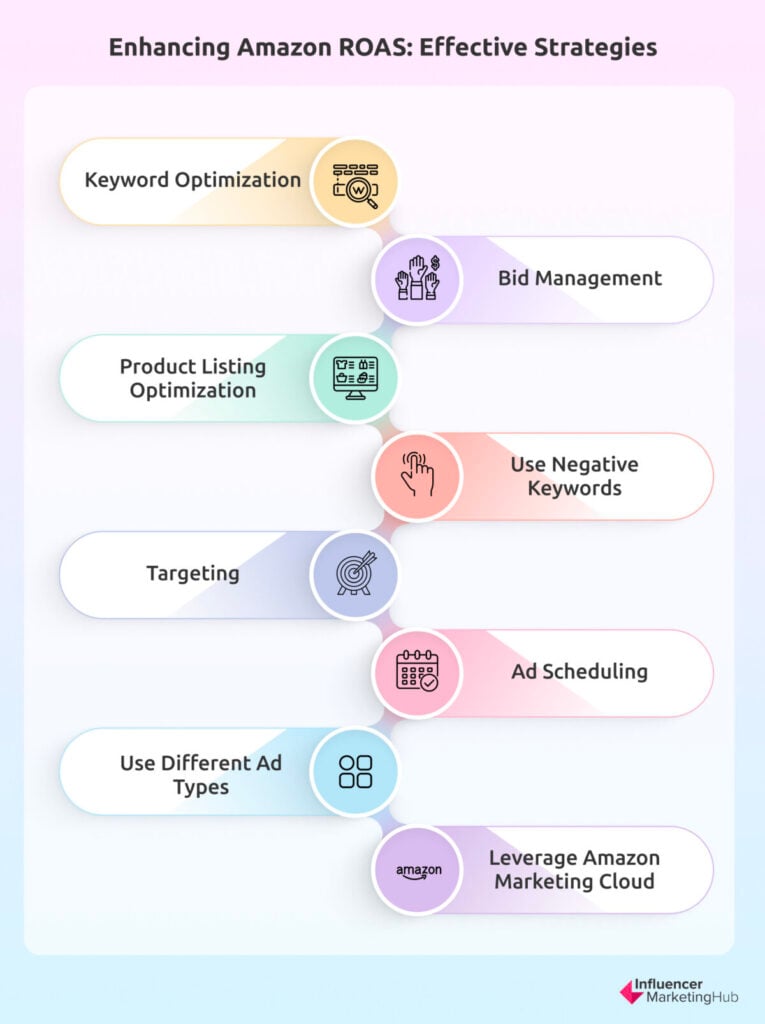
Keyword Optimization
Use relevant and specific keywords for your products. Regularly review your keyword performance and remove those that are not converting well.
Bid Management
Adjust your bids based on the performance of your keywords. Higher bids should be placed on high-performing keywords, while lower bids can be used for those that are not performing as well.
Product Listing Optimization
Ensure your product listings are optimized with high-quality images, detailed and accurate descriptions, and positive customer reviews. This can help increase your conversion rate, thereby improving your ROAS.
Use Negative Keywords
By adding irrelevant search terms to your negative keyword list, you can prevent your ads from showing up for those searches. This can help reduce wasted ad spend on clicks that are unlikely to convert.
Targeting
Use precise targeting options to reach the right audience. This includes using product targeting to reach customers who are viewing specific products or categories, and audience targeting to reach customers based on their shopping behaviors.
Ad Scheduling
Run your ads at times when your target audience is most likely to be online and shopping. This can help increase the effectiveness of your ads and improve your ROAS.
Use Different Ad Types
Amazon offers a variety of ad types, including Sponsored Products, Sponsored Brands, and Sponsored Display. Each has its own strengths, so using a mix can help reach more potential customers and improve ROAS.
Leverage Amazon Marketing Cloud (AMC)
AMC provides advanced data analysis, helping you understand how different ad formats work together to generate sales. This can provide insights to optimize your ad strategy and improve ROAS.
Improving ROAS is a continuous process that involves regular monitoring, testing, and optimization of your Amazon advertising strategy.
Final Thoughts
Amazon advertising statistics only reflect the average performance of all Amazon advertisers. Your ad's performance can be vastly different depending on your product, niche, and target market.
When considering these metrics, it is important to strike a balance between impressions, clicks, and conversions and ensure that your overall business remains profitable despite spending on ads. Ultimately, the goal should be to depend more on organic traffic than paid traffic as the former is a more sustainable way of running an eCommerce business.
Frequently Asked Questions
Why is Amazon’s conversion rate so high?
Amazon’s conversion rate is better than other eCommerce websites because it has a consumer-centric convenience program. Amazon Prime offers huge perks to its members including free two-day shipping. This has greatly encouraged consumers to sign up and patronize Amazon for their online shopping needs. Amazon Prime conversion rates are the highest in the industry at 74%.
What percentage of eCommerce transactions is on Amazon?
Almost 50% of the US eCommerce market buys on Amazon. The company dwarfs the competition in terms of market share. Amazon’s market share in the US is 49.1%, a far cry from the 2nd largest platform, eBay, which has a market share of 6.6%.
Why is CPC high on Amazon?
CPC bidding is based on keywords and the more search volume a keyword generates, the more popular and expensive it gets. For example, a popular term like “adult diapers” will be more expensive than “incontinence pads” although both mean the same thing. Advertisers know that targeting popular keywords will increase the chances of their impressions and, hopefully, conversions. You can bid aggressively on popular keywords as long as your conversions prove that the CPC is worth it.


